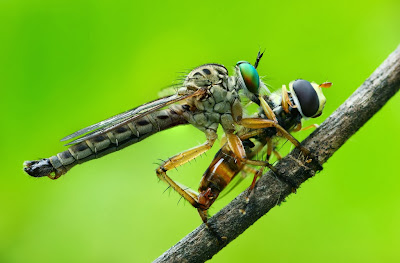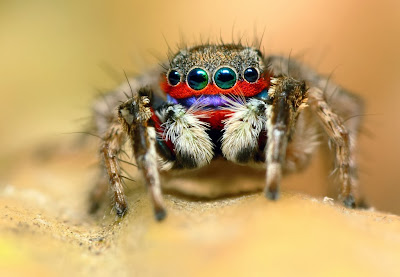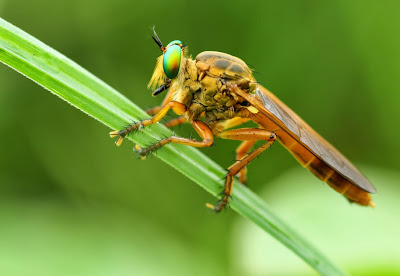Close up lenses are also called close up filters as they are designed to screw on to the filter thread in the front of your lens, just the same as any other filter. They act like a magnifying glass placed between your subject and your camera lens. when a close up filter is attached to a lens the lens's effective focal length is decreased. The minimum focusing distance of the lens is also reduced there by allowing greater magnification.
The magnifying power of close up lenses / filters are specified in terms of "diopters". Most commonly available are in the range of +2 to +4 diopters. The higher the number the greater the magnifying power. For extreme macro photography there are some high power closeup lenses available in the range of +10; it is also possible to stack multiple filters to achieve even higher magnifications.
Types of Close Up Lenses
There are two types of close up lenses they are:
1. Single Element Close Up Lens
As the name suggests, Single Element close up lenses have only one optical element in them; they are cheaper than those which feature double elements, but provide less image quality. Lack of edge sharpness and chromatic aberrations are common issues with them especially when used at wide open apertures.
2. Double Element Close Up Lens
Double element close up lenses also known as dual element or achromatic close up lenses have a design that features two optical elements. The second element is used to correct the defects of the first and this results in much improved image quality than single element filters especially noticeable towards the corners. Double element close up filters are much more expensive than single element close up filters.
Tips for getting the most out of your close up filters
1. Close up lenses yield greatest magnification when used with longer focal length lenses.
For example
a +10 diopter on a 50mm lens will only give you magnification of 0.5X where as the same magnification could be achieved on a 200mm lens with just a +2.5 diopter.
2. Generally Close-up lenses are not corrected for optical aberrations and this causes quality loss especially towards the edges. Stop down your lens couple of stops for getting better image quality. Bear in mind the issue is more pronounced when shooting with longer focal length lenses (as magnification increases so does the defects in lenses and filters). Use high quality filter on tele lenses to reduce such issues.
3. To attain higher magnifications it is possible to use close up lenses stacked. The effect of stacking closeup lenses is additive so combining a +2 and +4 diopters will give you results equivalent to a +6 diopter.
4. Stacking more than two close up filters is not recommended due to loss in image quality.
5. To get better results when stacking close up lenses make sure you mount the stronger one (one with higher diopter) directly on the camera lens.
6. Like UV and other filters, the make of close up filters is not important. They can be used on any camera regardless of the brand. The important point is to make sure the diameter of your close up filter and that of your lens filter thread match.
7. Attaching a close up filter does not affect the focusing and metering ability of your camera. So you will be able to autofocus just as normal and exposure metering also works just fine. However you will not be able to focus on infinity (at objects located very far) with the close up lens attached.
8. A close up lens does not restrict the amount of light passing through the lens and so the viewfinder does not grow dark when they are attached.
Advantages and Disadvantages of using close up lenses for macro photography
Advantages of Close Up Lenses
1. They are Small, light weight, easy to carry.
2. They provide more magnification than extension tubes especially when used with longer focal length lenses.
3. They are Not expensive especially single element models.
4. They don’t affect exposure.
5. To attach close up lenses one need not dismount the lens from the camera body thus reducing chances of dust entering the sensor.
6. Viewfinder brightness is not affected making it easier to focus.
7. Autofocus works as normal.
Disadvantages of Close Up Lenses
1. Image quality suffers when used at wide apertures.
2. Difficult to work with in the field, in-order to change magnification one need to add or remove filters and experiment with different combinations.
3. For each filter size you will need a different close up filter set; they are also not available for filter sizes greater than 77mm.
4. The lens cannot focus at infinity (at far away objects) when a close up lens is attached.
5. Image definition provided by close up lenses are not as good as a dedicated macro lens.
6. Not very useful when used with shorter focal length lenses as they provide only very little magnification.
7. Low quality filters could significantly reduce the image quality.
8. It may not be possible to use other filters with a close up lens attached.
Here are some shots taken mostly with canon 550d,sigma 105mm,raynox dcr 250.
 |
| Photo by: Karthi Keyan S |
 |
| Photo by: Karthi Keyan S |
 |
| Photo by: Karthi Keyan S |
 |
| Photo by: Karthi Keyan S |
 |
| Photo by: Karthi Keyan S |
 |
| Photo by: Karthi Keyan S |
+Filters.jpg) |
| Photo by: Karthi Keyan S |
